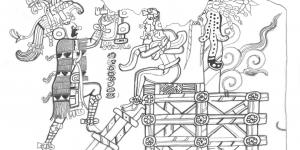You are here
Why Are Lehi’s and Nephi’s Visions and Histories Similar to the History of the Rechabites?

1 Nephi 8:10-11
The Know
Jeremiah 35 includes a brief mention of the Rechabites, who were descendants of Rechab through his son Jonadab. They are described as a familial group of covenant-keeping Jews who were told that they would “live many days in the land where ye be strangers” (Jeremiah 35:7). Because of their loyalty to the Lord, Jeremiah promised them that “Jonadab the son of Rechab shall not want [i.e. lack] a man to stand before [the Lord] for ever” (Jeremiah 35:19). Because of this promise, many Jewish traditions presume that the Rechabites (like Lehi) fled Jerusalem before it was destroyed by Babylon, leaving for a better land where they could serve the Lord.1
One of these texts, known as either the Narrative of Zosimus or the History of the Rechabites, contains some of the most explicit and intriguing teachings regarding the Rechabites following their purported exodus from Jerusalem. This text follows a man named Zosimus, who was a righteous man living in a desert cave. After praying to the Lord for admission to the land of blessedness, he is miraculously taken there, where he meets and converses with the Rechabites. The Rechabites, it is revealed, had fled Jerusalem during Jeremiah’s ministry, traveled through a desert, and crossed a great body of water to enter a blessed land where they could keep the commandments of the Lord.
While portions of this text appear to be later Christian additions, James H. Charlesworth has observed that the text itself seems to have been originally a Jewish composition predating the second century AD and may contain even earlier traditions.2 What is even more significant, however, is how many aspects of this text are reflected in the early chapters of the Book of Mormon. This is especially evident when the Narrative of Zosimus is read side-by-side with Lehi’s and Nephi’s vision of the Tree of Life in 1 Nephi 8–15. Indeed, many parallels exist between these two significant texts that are worth exploring in greater depth, as John W. Welch has done.3
For example, in the Narrative of Zosimus, we read that Zosimus prayed for many days to see and enter the land of the Blessed Ones. After praying one day, “a voice came to him and an angel came toward him” who led Zosimus on a journey to this land. Furthermore, Zosimus tells that after he had traveled with the angel for forty days, “I arrived at a certain place wearied and fatigued, and I collapsed from my exhaustion.”4 Eventually, after praying for additional help, Zosimus arrived at the shore of “the great ocean” (or a large river in other textual recensions) where he communed with the Lord, hoping to enter the land of the Blessed Ones.5
In answer to Zosimus’s prayer, “two trees sprang up out of the earth, fair and beautiful, laden with fragrant fruits,” one on either side of the body of water, that helped Zosimus cross over to the other side.6 These trees, it will be revealed, were used by the Blessed Ones for sustenance, as “they eat what they need from the fruits of these trees” and “water which is sweet and delightful as honey flows from the roots of the trees.”7
This is remarkably similar to the beginning of Lehi’s vision. At the outset of his dream, Lehi reports, “I saw a man, and he was dressed in a white robe; and he came and stood before me. And it came to pass that he spake unto me, and bade me follow him” (1 Nephi 8:5–6). As in the account of Zosimus, this angel acts as a guide during the initial portion of the vision. Similarly, an angelic guide was key to Nephi’s vision, which expounded on Lehi’s dream shortly after (see 1 Nephi 11–14).
The angel takes Lehi through “a dark and dreary waste … for the space of many hours” (1 Nephi 8:7–8). Lehi “is apparently disoriented and weary from his many hours of travel when he pleads for mercy.”8 Lehi’s prayer is answered by beholding the Tree of Life, which Lehi describes as follows: “I beheld a tree, whose fruit was desirable to make one happy. And it came to pass that I did go forth and partake of the fruit thereof; and I beheld that it was most sweet, above all that I ever before tasted. Yea, and I beheld that the fruit thereof was white, to exceed all the whiteness that I had ever seen” (1 Nephi 8:10–11). When Nephi saw this same vision, he went on to report that this tree was closely associated with “the fountain of living waters,” similar to the trees in Zosimus’s vision that contained springs of life-giving water (1 Nephi 11:25).
Finally, Zosimus reports his encounter with the Rechabites, who were living in this land across the great ocean. After Zosimus had met with many of them, they recounted their history, which they wrote on “tablets of stone.”9 According to their history, they had fled from Jerusalem before it was destroyed by the Babylonians and were likewise led through the desert and across the great body of water to this blessed land. The Nephites used similar means to record their own history after they had been led through a desert and across a great ocean to the promised land. Nephi reports that after they arrived in the Americas, he made “plates of ore that I might engraven upon them the record of my people” (1 Nephi 19:1).10
The Why
The connections between the Book of Mormon and the Narrative of Zosimus become even more intriguing as further texts are added to our awareness. For example, other details about the Rechabites found elsewhere in Jewish literature match additional details of Lehi’s exodus from Jerusalem. Medieval rabbis, for instance, connected the Rechabites to Jews living in the Arabian Peninsula and specifically in areas along the Frankincense Trail, which Lehi likely used.11
Additionally, as noted in Jeremiah 35:7–10, the Rechabites were recognized for their exceptional covenantal loyalty, for which they were promised to be able to stand in the Lord’s presence (Jeremiah 35:19). This is likewise similar to the Nephites, who were promised, “Inasmuch as ye shall keep my commandments ye shall prosper in the land; but inasmuch as ye will not keep my commandments ye shall be cut off from my presence” (2 Nephi 1:20).12
Other ancient texts also share many important parallels with the stories of the Rechabites and Lehi’s vision of the Tree of Life. For example, C. Wilfred Griggs has pointed to the body of Orphic literature originating within a Greek mystery religion. Some of these poems were written on gold plates and buried with the dead, offering instructions to the deceased on how they might enter the presence of the gods. According to these poems, the righteous could avoid a destructive and filthy river and instead approach a white or shining cypress tree and drink living waters and dwell with the gods.13
Other similar traditions have been found in Egypt.14 The similarities between these texts and the vision of the Tree of Life seen by Lehi and Nephi, according to Griggs, offer a “demonstrable compatibility with the ancient Near Eastern origin which [the Book of Mormon] claims” that cannot easily be ignored.15 In addition, other apocryphal texts connected to Enoch and Enosh in the Bible likewise contain similarities to Lehi’s vision of the Tree of Life, further strengthening the Book of Mormon’s claims to have roots in the ancient Near East.16
While it is difficult to tell how early Israelite or Near Eastern tradition shaped either the Narrative of Zosimus or even Nephi’s retelling of his vision with any certainty, John W. Welch has noted that it is possible “a third text or tradition could stand behind both the writings of Lehi and the Narrative of Zosimus” that helped shape the understandings of both groups of people. Thus, as Welch has observed, “people have reserved interest in the Book of Mormon by wondering if any other ancient Near Eastern texts closely resembled it. On that score, one need no longer wonder.”17 This same conclusion has been reached by Hugh Nibley. After considering traditions regarding the Rechabites’ journey into the wilderness and subsequent religious practices (not unlike those depicted in the History of the Rechabites), Nibley concluded that “one is forced to admit at very least the possibility that Lehi’s exodus could have taken place in the manner described, and the certainty that other such migrations actually did take place.”18
It is also worth remembering that the Narrative of Zosimus, like these other non-biblical texts, would have been inaccessible to Joseph Smith in 1830. The Narrative of Zosimus was first translated into English in 1872, over forty years after the Book of Mormon had been translated into English. As such, it would have been impossible for Joseph to know about the contents of these ancient Near Eastern texts that so closely match the vision seen by Lehi and Nephi. All this helps demonstrate the ancient context behind the Book of Mormon and invites readers to take it more seriously as an ancient text brought forth by the gift and power of God to bring happiness and salvation to peoples in all corners of the world.
Further Reading
John W. Welch, “The Narrative of Zosimus (History of the Rechabites) and the Book of Mormon,” in Book of Mormon Authorship Revisited: The Evidence for Ancient Origins, ed. Noel B. Reynolds (Provo, UT: Foundation for Ancient Research and Mormon Studies [FARMS], 1997), 323–374.
Jeffrey P. Thompson and John W. Welch, “The Rechabites: A Model Group in Lehi’s World,” in Glimpses of Lehi’s Jerusalem, ed. John W. Welch, David Rolph Seely, and Jo Ann H. Seely (Provo, UT: FARMS, 2004), 611–624.
Hugh Nibley, An Approach to the Book of Mormon, 3rd ed. (Salt Lake City, UT: Deseret Book; Provo, UT: FARMS, 1988), 68–69, 146, 151.
John W. Welch and Spencer Kraus, The Narrative of Zosimus: Greek and Syriac Versions with Book of Mormon Comparative Notes (Springville, UT: Scripture Central, 2024).
- 1. For a brief discussion on the historical background of the Rechabites, see Hugh Nibley, Teachings of the Book of Mormon, 4 vols. (Provo, UT: Foundation for Ancient Research and Mormon Studies [FARMS]; American Fork, UT: Covenant Communications, 2004), 1:61–62.
- 2. See James H. Charlesworth, “History of the Rechabites,” in Old Testament Pseudepigrapha, ed. James H. Charlesworth, 2 vols. (New York, NY: Doubleday, 1985), 2:444–445.
- 3. For Welch’s most in-depth study regarding the Narrative of Zosimus and the Book of Mormon, see John W. Welch, “The Narrative of Zosimus (History of the Rechabites) and the Book of Mormon,” in Book of Mormon Authorship Revisited: The Evidence for Ancient Origins, ed. Noel B. Reynolds (Provo, UT: FARMS, 1997), 323–374; John W. Welch, “The Narrative of Zosimus and the Book of Mormon,” BYU Studies Quarterly 22, no. 3 (1982): 311–332. In each of Welch’s publications, a side-by-side comparison is given between the Narrative of Zosimus and the Book of Mormon. This is also available in John W. Welch and Spencer Kraus, The Narrative of Zosimus: Greek and Syriac Versions with Book of Mormon Comparative Notes(Springville, UT: Scripture Central, 2024).
- 4. Narrative of Zosimus 1–2. Unless otherwise noted, all citations to the Narrative of Zosimus / History of the Rechabites will come from Charlesworth’s translation of the Syriac version found in Charlesworth, “History of the Rechabites,” 2:450–461. A Greek recension of this text is also available and can be found in Alexander Roberts and James Donaldson, eds., The Ante-Nicene Fathers: The Writings of the Fathers down to A.D. 325 (Edinburgh, UK: T & T Clark, 1872), 10:220–224. An additional recension of this text, which includes far more Christian additions, can be found in the Ethiopic language, translated into English in E. A. Wallace Budge, The Life and Exploits of Alexander the Great, vol. 2 (London, UK: Cambridge University Press, 1896), 555–584. An early manuscript of the Narrative of Zosimus includes a note that the text was “translated from Hebrew into Greek and from Greek into Syriac by the Hands of the Reverend Mar Jacob of Edessa.” However, as noted by Charlesworth, textual criticism of both the Greek and Syriac recensions paint a complex picture, hence “it is unwise to state the probable original language, date, or provenance of this document until critical editions of the Greek, Syriac, and Ethiopic texts are available.” He also cautioned that “it is practically impossible to discern the provenance of this document.” Charlesworth, “History of the Rechabites,” 444–445.
- 5. The Greek version of the text instead says this body of water was a large river that could not be crossed by normal means.
- 6. Narrative of Zosimus 3. Translation taken from the Greek recension.
- 7. Narrative of Zosimus 7.
- 8. Welch, “Narrative of Zosimus (History of the Rechabites) and the Book of Mormon,” 334.
- 9. Narrative of Zosimus 8.
- 10. For a discussion on the ore used by Nephi, see Book of Mormon Central, “What Kind of Ore Did Nephi Use to Make the Plates? (1 Nephi 19:1),” KnoWhy 22 (January 29, 2016).
- 11. See Israel Friedlaender, “The Jews of Arabia and the Rechabites,” Jewish Quarterly Review 1 (1911): 252–257, and his sources for a discussion on the connection between the Arabian Peninsula and the Rechabites. As late as 1988, Hugh Nibley was aware of some who claimed to be descendants of the Rechabites who continued to live the lifestyle described in Jeremiah 35:7–10. See Nibley, Teachings of the Book of Mormon, 1:96. For an analysis of the Frankincense Trail as a route Lehi would have taken, see Evidence Central, “Book of Mormon Evidence: The Frankincense Trail,” Evidence 188, April 26, 2021.
- 12. For other parallels between the Rechabites and Lehi, see Jeffrey P. Thompson and John W. Welch, “The Rechabites: A Model Group in Lehi's World,” in Glimpses of Lehi’s Jerusalem, ed. John W. Welch, David Rolph Seely, and Jo Ann H. Seely (Provo, UT: FARMS, 2004), 611–624; Hugh Nibley, An Approach to the Book of Mormon, 3rd ed. (Salt Lake City, UT: Deseret Book; Provo, UT: FARMS, 1988), 68–69, 146, 151.
- 13. See C. Wilfred Griggs, “The Book of Mormon as an Ancient Book,” in Book of Mormon Authorship: New Light on Ancient Origins, ed. Noel B. Reynolds (Provo, UT: Religious Studies Center, Brigham Young University, 1982), 79–87, for a discussion of these texts and traditions.
- 14. See Griggs, “Book of Mormon as an Ancient Book,” 87–91.
- 15. Griggs, “Book of Mormon as an Ancient Book,” 94. For more on the ancient Near Eastern links to the Orphic traditions, see Carolina López-Ruiz, “Near Eastern Precedents of the ‘Orphic’ Gold Tablets: The Phoenician Missing Link,” Journal of Ancient Near Eastern Religions 15 (2015): 52–91.
- 16. See Book of Mormon Central, “What Does an Ancient Book about Enoch Have to Do With Lehi’s Dream? (1 Nephi 12:16–17),” KnoWhy 404 (February 1, 2018); Evidence Central, “Book of Mormon Evidence: Nephi’s Vision and the Apocalypse of Enosh,” Evidence 126, December 18, 2020. Hugh Nibley has also compared Lehi’s vision of the tree of life to ancient Bedouin lifestyle and literature, further showing the ancient Near Eastern setting for the early chapters of the Book of Mormon. See Nibley, Approach to the Book of Mormon, 253–264; Hugh Nibley, Lehi in the Desert / The World of the Jaredites / There Were Jaredites (Provo, UT: FARMS, 1988), 43–46.
- 17. Welch, “Narrative of Zosimus (History of the Rechabites) and the Book of Mormon,” 367, 368.
- 18. Nibley, Approach to the Book of Mormon, 69.
KnoWhy Citation
Related KnoWhys
Subscribe
Get the latest updates on Book of Mormon topics and research for free





